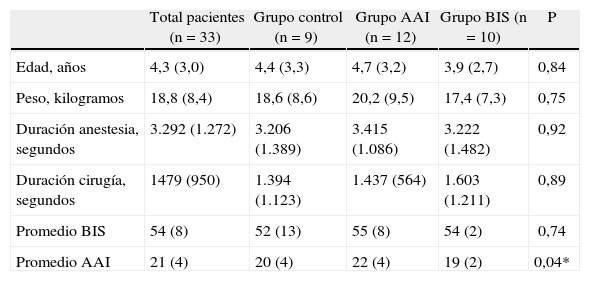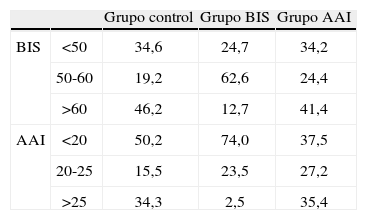Evaluación comparativa de los índices proporcionados por BIS® y AEP Monitor® durante el mantenimiento de la anestesia en pacientes pediátricos. Objetivos secundarios comparar el consumo anestésico y el tiempo de despertar.
Material y métodoPacientes con edades entre 6 meses y 12 años sometidos a anestesia inhalatoria con sevoflurano, bloqueo nervioso peneano o caudal y monitorización con BIS®, y AEP Monitor®. Se aleatorizaron en tres grupos según el monitor utilizado para dosificar sevoflurano: grupo BIS, grupo AAI y control. Se recogieron automáticamente BIS y AAI, fracción espirada de sevoflurano, parámetros hemodinámicos y tiempo de despertar.
ResultadosSe incluyeron 35 pacientes. Se encontraron diferencias significativas entre los índices recogidos dependiendo del monitor utilizado. El AAI fue más bajo en el grupo controlado por BIS respecto al controlado por AEP Monitor/2 (media [SD], 19 [2] vs 22 [4]; p=0,04). Hubo una buena concordancia entre BIS y AAI salvo en los valores extremos, sobre todo, los inferiores (ecuación de Bland-Altman). El consumo de sevoflurano y el tiempo de despertar no fueron diferentes entre grupos. Se estableció correlación positiva entre los dos índices (coeficiente de correlación de Pearson 0,207; p<0,001).
ConclusionesLa guía de la anestesia con BIS, respecto al AEP Monitor proporcionó un índice más estable y profundizó más la hipnosis. Ambos índices presentaron una buena correlación durante el mantenimiento. Ninguno de los monitores presentó ventajas respecto a una práctica clínica estándar en la incidencia de movimiento, gasto anestésico o tiempo de despertar.
To compare the indices computed by a bispectral (BIS) monitor and an auditory evoked potential (AEP) monitor during maintenance of anesthesia in pediatric patients. A secondary objective was to compare anesthetic consumption and recovery times.
Material and methodsPatients aged 6 months to 12 years under inhaled anesthesia with sevoflurane were administered a penile or caudal nerve block. BIS and AEP monitoring was then started. The patients were randomized to 3 groups in which the sevoflurane dosage was guided by the BIS index, the A-line ARX index (AAI), or standard procedures (control group). The BIS index, the AAI, the fraction of expired sevoflurane, hemodynamic parameters, and recovery time were the variables recorded for all patients.
ResultsThirty-five patients were enrolled. Significant differences between the 2 monitor groups were observed. The mean (SD) AAI was lower in patients whose dosage was controlled by the BIS index (19 [2]) than in those whose dosage was based on the AEP monitor's reading (22 [4]) (P=.04). According to a Bland and Altman plot, there was good agreement between the BIS index and the AAI except for the highest and, in particular, the lowest values. The volumes of sevoflurane used and the recovery times were similar between groups. There was a positive correlation between the 2 indices (Pearson correlation coefficient, 0.207; P<.001).
ConclusionsBIS monitoring provided a more stable index than did AEP monitoring and BIS-index guidance achieved a deeper level of hypnosis. There was good correlation between the 2 indices during maintenance of anesthesia. Neither monitor offered advantages over standard procedures with regard to movement, volume of anesthetic consumed, or recovery time.
Artículo
Comprando el artículo el PDF del mismo podrá ser descargado
Precio 19,34 €
Comprar ahora














